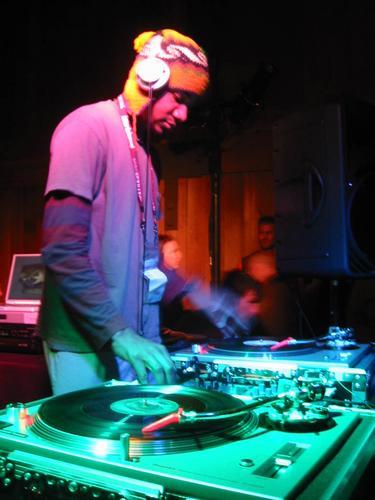Get your feet to dance to the beat
Interview with
 Ever been on the dance floor, getting your groove on, enjoying a particular tune, and then the DJ flips the song over, and it completely messes up your dancing moves? I have! Then there's been other times when I haven't even noticed the tune changing
Ever been on the dance floor, getting your groove on, enjoying a particular tune, and then the DJ flips the song over, and it completely messes up your dancing moves? I have! Then there's been other times when I haven't even noticed the tune changing
But what's the science behind this DJ skill? Well, Mark Elliott, Research Fellow at Birmingham University thinks he's found the answer.
Hannah - Hello. So, what makes a good DJ?
Mark - So, a good DJ basically needs to mix two songs together seamlessly. So basically, it will sound like this...
(sound)
Mark - So, they've got to take two beat lines from two separate songs and then closely match them up together so they sound like a common beat. And if they get to be wrong, it can sound pretty horrible and sound like this...
(sound)
Mark - That's enough to put you off your dancing and is literally only like a few tens of milliseconds out. So, what we wanted to find out is how accurately those beat lines need to be matched for people to start moving in time to them as if they were a single common beat.
Hannah - How did you study that then? Did you go out to lots of clubs and start measuring people's dance moves?
Mark - It wasn't quite that exciting. So, we did a lab-based experiment where people basically had to just tap along to 2 metronomes played at the same time. So, what we did with those metronomes is vary the separation between them and also, the consistency and the predictability of the beats of the separate metronomes. So, we've probably got some examples I think...
(sound)
So, this is a consistent metronome where we just separate the two beats apart.
(sound)
And then this is an inconsistent metronome where the beats are no longer predictable. So, what we found was that if the individual metronomes are very consistent then they had to be very closely matched in time. So, there's not much separation between them for them to be considered as a common beat whereas on the other hand, if they're inconsistent and less predictable, then the separation could actually be larger and we still would consider them a common beat.
Hannah - So, does this mean that good DJs can mix common beats together in a seamless way, but if you're not quite so talented then you should either possibly use the fade button or try and use more irregular beats so that maybe our maybe our brains won't notice or perceive the difference?
Mark - Possibly. I mean, what we're showing is that because DJs would tend to play a very regular strong common beat with a strong beat that's very predictable then they've got to get it very accurately aligned to convince the audience that they're dancing to a single common beat when they mix it. So, they've actually got quite a hard task.
Hannah - So, there's obviously some very important applications of your research on the dance floor, but what about elsewhere in the world?
Mark - Yeah. So, we're now applying our model to quite a different situation where we're looking at synchrony within crowd movements. So for example, if you think of a football crowd, in a stadium if they get excited, they tend to all jump up and down together. And this can actually be quite a problem for structural vibration in the stadium. So, what we're looking at now is how and when people start moving together. It's kind of a similar situation because these people moving together, they're effectively defining a common beat between them. But rather than just combining sound, here, they've got a vision and maybe touch from looking at the other people around them. What we're looking at is how do they use all this conflicting information from across all different senses to actually quite simply make a common beat between them and do spontaneously start jumping up and down together.
Hannah - Thank you very much for joining us. That was Mark Elliott from Birmingham University and that study was published this week in the Proceedings B of Royal Society.
- Previous Dengue World Cup
- Next The Longitude Prize









Comments
Add a comment